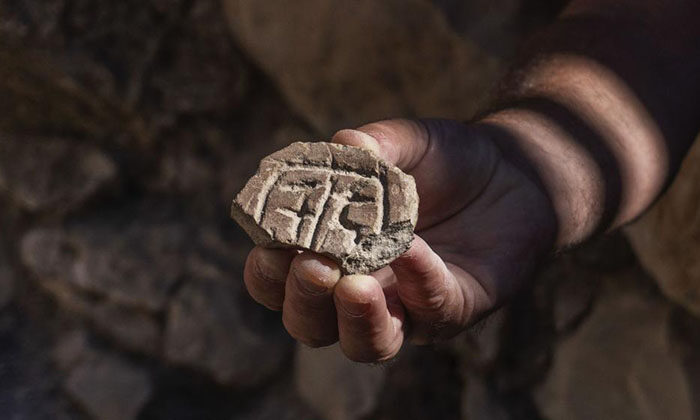How did Jerusalem deal with the tremendous destruction wrought upon her by the Babylonian army in the 6th century BC?
A double stamp impression on a bulla and a seal made of re-used pottery shards, dated with high probability to the Persian period, may provide an answer to this question.
The findings were discovered in the course of archaeological excavations undertaken by the Israel Antiquities Authority [IAA] and Tel Aviv University in the Givati parking lot excavation of the City of David in the Jerusalem Walls National Park. They were found next to the rubble of a large structure that was destroyed during the Babylonian destruction of Jerusalem.
According to Prof. Yuval Gadot of the Department of Archaeology and Ancient Near Eastern Cultures at Tel Aviv University and Dr. Yiftah Shalev of the IAA: “Despite the numerous excavations conducted in Jerusalem to date, so far the findings revealed from the Persian period are extremely meager and therefore we lack information regarding the character and appearance of the city during this period. The researchers emphasized that: “Discovering these artifacts in an archaeological context which can be dated with a high probability is very rare.”
The seal impression—bullae—were small pieces of clay used in ancient times to sign documents or containers (for example, storage jugs for agricultural produce collected as a tax), and were intended to keep them sealed en route to their destination. Oftentimes, the objects on which the seals were stamped were themselves left unopened or did not endure (especially the documents), but the bullae remained preserved, leaving evidence of the administrative authorities, and even of the people representing them.
According to Prof. Gadot and Dr. Shalev: “The finding of the stamp and seal impression in the City of David indicates that despite the city’s dire situation after the destruction, efforts were made to restore the administrative authorities to normal, and its residents continued to partly use the structures that were destroyed.”
The double seal impression was discovered on a large piece of clay. The size of the clay piece, about 4.5 cm [1.77 in], indicates that it was used to seal a large container—perhaps a jar—and not a document. The imprint bears the image of a person sitting on a large chair with one or two columns in front of him. The design of the image is indicative of a Babylonian-style composition. The character is probably a king and the columns are the symbols that represent the gods Nabu and Marduk.
According to Dr. Ido Koch of the Department of Archaeology and Ancient Near Eastern Cultures at Tel Aviv University, only about ten artifacts of this style have been found in Israel, in places such as Ein Gedi and Jerusalem, which appear to have been in use during the Persian period. Another bulla of this style, also from the Persian period, was discovered in excavations carried out by Dr. Eilat Mazar on the eastern slope of the City of David.
The seal is made of a large, locally-made pottery shard, with a circular frame engraved on its outer side, and is divided into two sections containing several linear inscriptions. The engravings probably represent two characters, and it may be a pseudo-epigraphic seal (bearing drawings designed to resemble letters). On the other side of the seal is a fragment, which may be indicative of a handle that was attached to it in the past. The size of the seal, about 8 cm [3.14 in] in diameter, indicates that it was used to seal large objects.
According to the researchers: “Discovering the new findings on the western slope of the City of David adds much information about the city’s structure during the period of the Return to Zion, a period we knew about mainly from biblical literature (the books of Ezra and Nehemiah). The paucity of the findings from this period made it difficult to understand the status and extent of the city. The findings from the Givati parking lot excavation shed light on the renewal of the local administration, in a location similar to the one that existed before the destruction of the First Temple, about 100 years prior.”

No comments:
Post a Comment